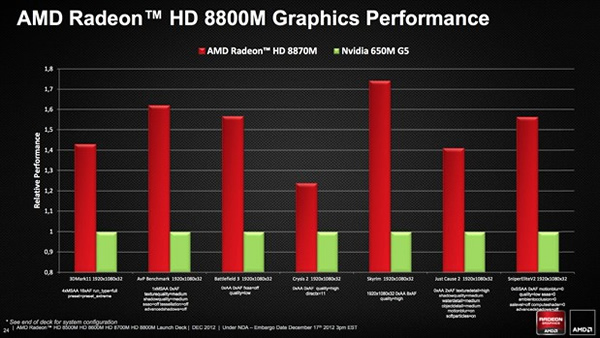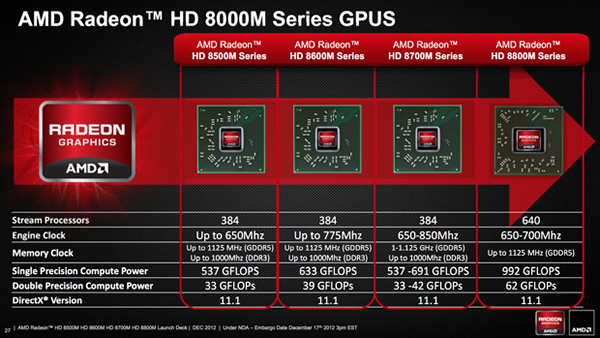I seriously don't understand what you are actually trying to explain with all your posts. Time after time, you constantly revert to either attacking AMD products or desperately defending NV, and thus the posters who say positive things about AMD products and god forbid anything negative about NV. You then turn everything anyone says about AMD as "product shilling" or blame someone as AMD biased right away
Maybe you should just read the substance of my posting rather than infer. But like most trolls you are only in posting to talk
at people. You have no interest in a dialogue except that it allows you to segue into your own diatribe.
My post commented upon the naming convention and
facts - pricing (see below) , market share, fabrication process, and strategy re: Richland. Personally, it doesn't bother me what you say regarding AMD, Intel or Nvidia- so long as it is factually correct and is not an isolated/cherry picked facet. You want to tell me how great the 7970M's performance is (and you did-see below), fine, but maybe you should also take into account the whole ecosystem (and you did, then promptly immediately contradicted yourself- see below) You're the one using my posting to fly off on a tangent to promote AMD's strengths along with screeds of benchmarks for a series of SKU's that this article- and my posting- had no interest in. All you posting ever seems about is an excuse to jump on a soapbox and write a wall of cherry picked circumstances that show AMD in a glowing light while presenting straw man arguments and then sending up walls of text when someone brings reality into the discussion....refusing to acknowledge any facets that run counter to your junior league AMD cheerleading...an no, I don't count "Nvidia/Intel product
X is OK for
Y, but here's a qualifier to refute the OK part" or "AMD product X has its faults but that's [insert excuse]"
If you like I can check our respective postings and note verified facts versus the wrong assumptions, outright lies and excuses. I have a fairly reasonable article on TS regarding AMD based entirely on fact from a personal knowledge base...I don't see any remotely unbiased content from you regarding Intel or Nvidia.
Regarding benchmarks, you seem to continue to ignore price. How convenient.
Obviously...
dividebyzero said:
HD 7000M parts are already priced much lower than Nvidia's 600 series (many of which are Fermi based)
And honestly next time you want to discuss GPU market share, at least come off as knowledgeable. A very large reason AMD lost so much market share suddenly is not because their products was much worse but because they couldn't afford to spend a lot of $ on winning OEM design wins with HD7000
And where did I say that "[AMD's] cards were much worse?" (Hint: Nowhere) Just another straw man argument and a lot of hyperbole...
dividebyzero said:
Hasn't stopped OEM's and consumers shopping for Nvidia's parts...which comes down to marketing, a lack of high ASP pro parts (last mobile FirePro card was two years ago- the M8900), and in large part, drivers
Nope. Don't see any mention of performance. Just a mention of Nvidia's better OEM relations, consistant pro graphics ecosystem, and less problematic mobile drivers at the current time.
If you want to believe that Apple dumped AMD in favour of Nvidia because the latter spent more on PR, then be my guest...plenty of people thought the world was ending last week as well. No accounting for the thought process.
The reason that OEMs were switching to Nvidia was primarily because of the longevity of their relationships, a reasonable dialogue with the IHV regarding mobile drivers, and the fact that the vast percentage of notebooks use an Intel CPU, and Nvidia's Optimus gives both a solid product as well as cutting AMD out of the picture.
But enough of the truth...lets revisit you paraphrasing a statement I didn't make...
Regarding high end parts, we have no information on HD8900M series so how can you say they are going to be crap when you haven't even seen their specs?
I didn't say they were crap. Please point out where I said anything of a sort. Yet more butthurt hyperbole.
AMD have two choices for the 8900M. A mainstream part already used for the 8800/8700's or a low-power version of the high-end desktop part. Doesn't take an Einstein to work out the probable performance requirements for either...especially since the same dynamic has existed since the first mobile graphics based on desktop GPUs.
That means the best gaming performance is plugged into an outlet with Enduro disabled to begin with
Do you even read about the tech? The reason the Enduro issue is an issue is that for more than a few mobile platforms, Enduro cant be disabled since their machines are muxless
If hypothetically AMD priced their GPUs at 50% less and they are 2x faster, it still doesn't mean they'll get OEM design wins. To get those design wins you need to be willing to spend $ on custom designs and be willing to work together with OEMs. It's not as simple as delivering a good performance/$ and performance/watt part only
So, you’d agree that performance and performance/$ aren’t the be-all-and-end-all ! But wait…in the your next post
HD7970M keeps up with GTX680M for less cost than a 384 shader GTX675M. But eh if you think 15 min of battery life saved is worth it to get a GPU 50% slower in games, or spending $350+ more for a 680M is worth it for that, by all means.
If you're going to argue, at least be consistent.
As for the rest of your rambling, maybe if you read what was writen rather than misreading and hyperbolizing you'd sound more coherent.

